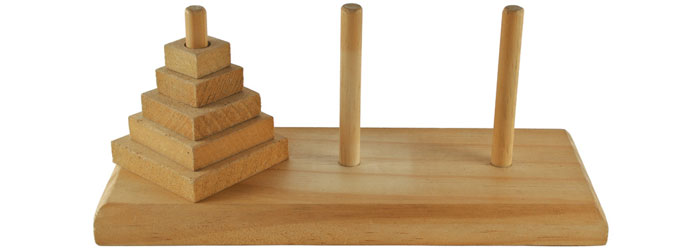


There are three poles in a row, the one on the left containing a series. Towers of Hanoi is a well known mathematical game/puzzle involving three pegs and a number of discs. Tower and sometimes pluralized as Towers, it is a mathematical game or puzzle. This story helps explain why the puzzle is sometimes called "The Tower of Brahma". In 1883, a French mathematician named douard Lucas came up with an intriguing scenario. The Tower of Hanoi is additionally called the Tower of Brahma or Lucas. When according to these rules the sixty-four discs shall have been transferred from the needle on which the Creator placed them to the third needle, the tower and the Brahmins will all crumble into dust, and that will be the end of the world." The priest must not move more than one disc at a time, he must only place this disc on an unoccupied needle, and then only on a disc larger than it. Night and day the priests are continually occupied in transferring the discs from the first diamond needle to the third, without infringing any of the fixed and immutable laws of Brahma.
HANOI TOWERS GAME HISTORY MANUAL
The puzzle starts with the disks in a neat stack in ascending order of size on one rod, the smallest at the top, thus. A MATLAB GUI for the popular Towers of Hanoi puzzle game with manual or. It consists of three rods, and a number of disks of different sizes which can slide onto any rod. On one of these needles God at the creation placed sixty-four discs of pure gold, the largest disc resting on the brass slab, and the others smaller and smaller to the top one. The Tower of Hanoi (also called the Tower of Brahma or Lucas' Tower, and sometimes pluralised) is a mathematical game or puzzle. "It is related that, in the great temple at Benares, beneath the dome which marks the centre of the world, one may see fixed in a brass-plate three diamond needles, a cubit high and as thick round as the body of a bee. Object: To move the tower from one post to another post The game called the Towers of Hanoi was invented by the French mathematician Edouard Lucas in 1883. The original leaflet contained this legend: The Tower of Hanoi game is a classical puzzle in recreational mathematics (Lucas 1883) which also has a strong record in pure mathematics. A great video by Elvia Moreno from Mexico animating the label above.


 0 kommentar(er)
0 kommentar(er)
